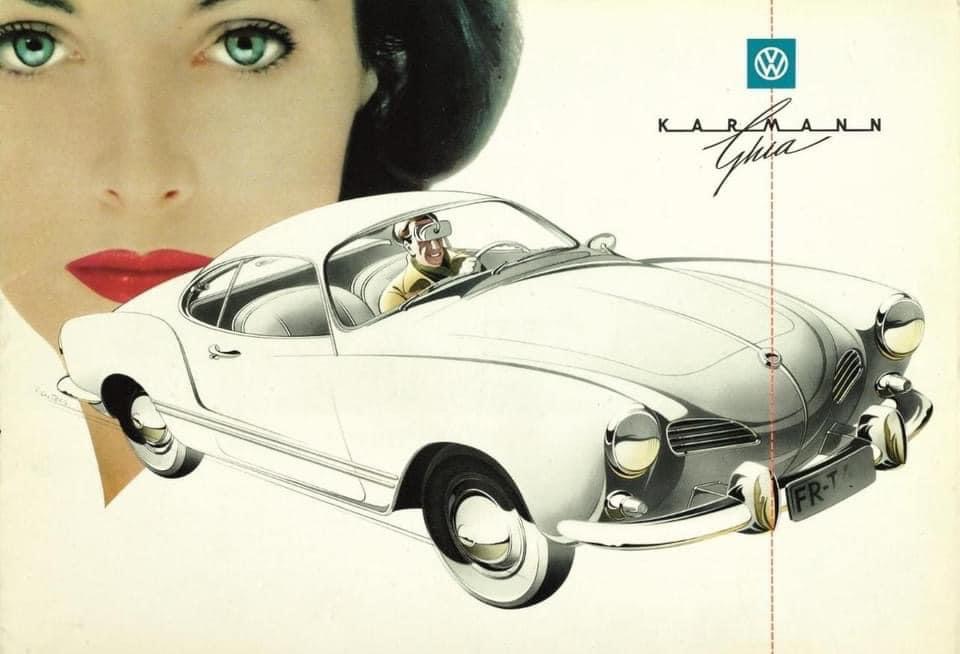
In the early 1950s, Karmann already possessed an agreement to construct the Beetle The cabriolet was produced at the Osnabrück plant, yet persuading Volkswagen to create a more athletic version proved challenging. Initially, VW dismissed Karmann’s early designs. It wasn’t until Karmann enlisted the help of the Italian design studio Ghia that things began to move forward. The project received approval to proceed. In true German pragmatic style, the automobile evolved into what we know as the Volkswagen Karmann Ghia. It made its debut in the U.S. market in 1956 with a price tag of $2395 via VW dealerships worldwide. This practical start led to the creation of one of the era’s most cherished and esteemed classic cars.
This admiration doesn’t stem from its performance or driving characteristics; the Karmann Ghia, also known as Type 14 in Volkswagen’s naming system, utilized the same 36 horsepower, 1192 cubic centimeter horizontally-opposed four-cylinder engine as the regular Beetle. Thanks to superior aerodynamic design, this streamlined coupé could reach speeds "above 70" miles per hour—surpassing the Beetle’s top speed of 68 mph—and boasted an estimated fuel efficiency of 32 miles per gallon. However, due to being more heavyset, the Karmann had slightly weaker acceleration when compared to its simpler counterpart. Yet these factors were irrelevant for enthusiasts captivated by the Ghia’s aesthetics. Furthermore, the introduction of the convertible version in 1958 heightened the allure of the Karmann, particularly within American markets.
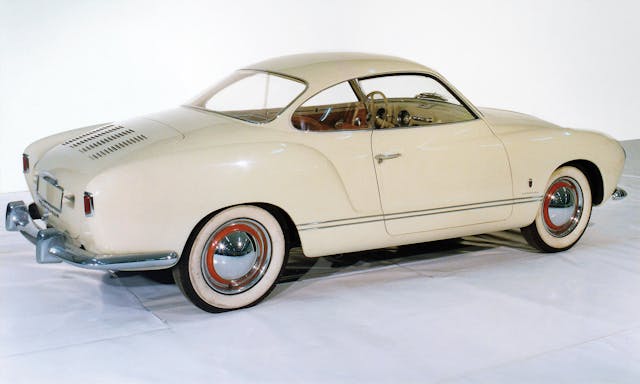
In 1958, bumper overriders made their debut. The following year, in 1959, a minor redesign raised the headlamps approximately two inches higher on the fenders, and stationary rear side windows gave way to ones that could be opened manually. Power increased for the model year 1961, with the 1192 cc engine delivering an additional 40 horsepower. Additionally, a transmission featuring full synchronization was introduced.
For 1966, changes involved the launch of the 1300 model, featuring a new 1285 cc inline-four engine delivering 50 horsepower, alongside switching to ball joints in the front suspension instead of kingpins for simpler upkeep. In 1967, Volkswagen incorporated the 1500 engine used in Beetles, accompanied by front disc brakes, a shift to 12-volt electrical systems, and wheel hubs secured with four bolts rather than the earlier five studs design. By 1968, VW added an optional Autostick semi-automatic gearbox to their lineup. Vehicles outfitted this way came with an independent rear suspension replacing the conventional swing axle configuration; starting '69, all models were standardized with IRS. To kick off 1970, Volkswagen installed a more powerful 57-horsepower, 1585-cc horizontally opposed four-cylinder under the hood, continuing until the conclusion of Karmann Ghia’s manufacturing journey in 1974 after producing around 445,300 units of the Type 14 series.
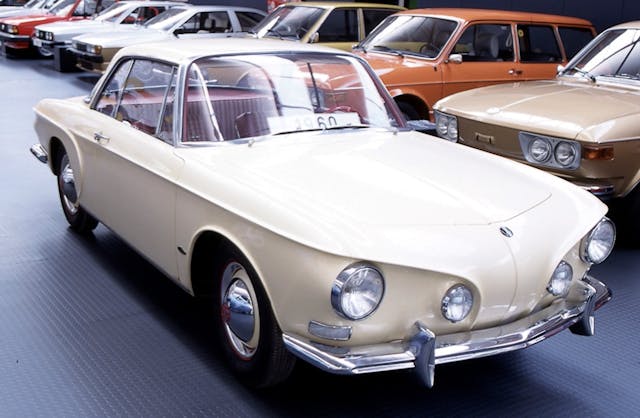
It’s worth noting the Type 34, which earned the nickname "Razor Edge" due to its design. This model was launched in 1961 and manufactured until 1969 exclusively in Europe. Unlike other variants, it was constructed using the chassis from the Type 3 Fastback/Squareback instead. the Beetle With the intention of providing a sportier, more upscale coupe experience, Volkswagen manufactured just 16 cabriolets derived from the Type 34 model, making these vehicles highly sought-after collectibles today. However, they produced over 42,000 coupes instead. It remains unclear why such an appealing automobile wasn’t made available in America; nonetheless, instances of seeing these cars around have increased recently. Some aficionados appreciate their distinctive appearance and limited availability even more so than the better-known yet perhaps conventionally prettier Karmann Ghia models.
What Is It Like to Drive a Karmann Ghia?
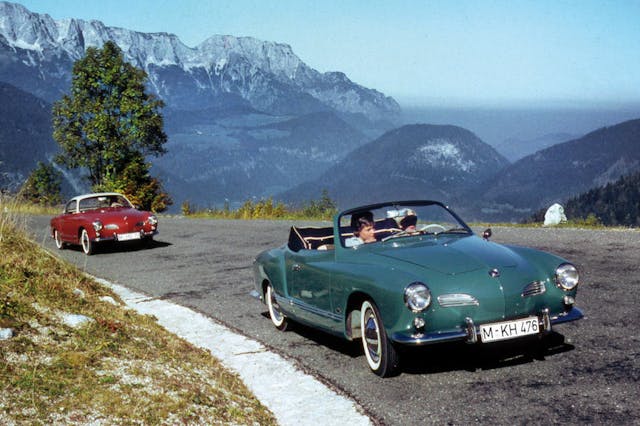
Anyone acquainted with a Volkswagen Beetle will immediately sense familiarity upon encountering the Karmann Ghia. This isn’t surprising since they utilize identical mechanical parts. One distinguishing feature noticeable in the Karmann is how the pedals seem even further off-center compared to the steering wheel relative to the driver's position. Those with bigger feet may want to opt for slim footwear due to the close spacing between the pedals; however, this becomes second nature after some time behind the wheel.
The all-round visibility inside the Karmann Ghia coupe’s fishbowl-like cockpit is outstanding, making tasks like parallel parking and changing lanes effortless. When the roof is raised, however, the convertible becomes cozier and obstructs your view behind the wheel somewhat; this shouldn’t deter you though. The remainder of the cabin remains minimalistic without being cluttered, yet consider the rear seats purely for storage purposes since they’re quite cramped—hardly suitable even for small kids.
When you start up any Karmann Ghia’s horizontally-opposed four-cylinder engine, it produces the familiar blend of sounds reminiscent of a sewing machine along with some rougher tones typical of air-cooled Volkswagens. Expect it to smoothly stabilize at idle speed. Engaging first gear using the conventional manual transmission is straightforward due to its common H-gate pattern. However, shifting may feel somewhat imprecise; this issue often resolves itself after lubricating or updating the linkage components. Models produced starting in 1961 feature full synchro gears across all ratios, making urban driving less demanding. As you progress through each gear change without hesitation, the motor provides ample torque for handling inclines effortlessly.
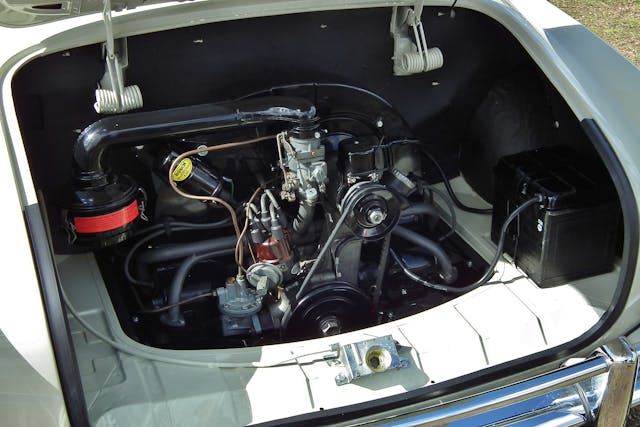
Don't be misled into thinking the Karmann Ghia is an agile vehicle, even with the highest-performing 1500 model, which remains leisurely when accelerating from stationary to highway velocities. While this might seem discouraging, remember that the VW isn’t alone in this aspect among cars of its era. It has the advantage of offering a more tranquil interior experience since much of its engine-generated noise gets carried away by the wind trailing the automobile. Similar to Beetles, numerous Karmann Ghias have undergone modifications aimed at boosting their motor output. Such enhancements may improve acceleration rates, yet we contend that the stock engines perform admirably enough. Adjusting one’s expectations rather than forcing the car to meet contemporary standards would likely serve both owner and machine well.
When in motion, the Karmann Ghia’s suspension effectively absorbs bumps and imperfections in the roadway. Vehicles equipped with an independent rear suspension from the latter part of the 1960s exhibit greater stability and assurance when navigating curves; however, every Karmann Ghia remains composed and provides precise steering devoid of any feedback resistance.
What Is the Price of a Karmann Ghia?

Many detailed distinctions can be found among Karmann Ghias from different years; however, these discrepancies do not significantly impact their worth unless the vehicle remains remarkably untouched since production. Some enthusiasts favor the "low beam" versions produced until 1959 due to their lower headlight positioning compared to updated models. Nevertheless, an equally substantial fan base exists for subsequent iterations which negates any potential difference in pricing. Consequently, you should anticipate spending approximately $13,000. An early coupe in #4 (average) condition That you can relish and enhance as you progress. A similarly maintained vehicle in #3 (good) condition would cost over twice as much, whereas an #2 (excellent) specimen might require almost $63,000 from your budget. A late-1960s 1500 coupe Meanwhile, this option is more budget-friendly, with #4 cars priced at approximately $8000, #3 cars costing about twice as much, and #2 cars ranging from roughly $33,000.
Coupes are more desirable, especially as they are better maintained. A 1958 in #4 condition will set you back around $15,000; an instance ranked at number 2 goes for approximately $69,000. For that same Late-'60s convertible version of the 1500 Karmann Ghia Allocate around $12,300 for a #4 car, twice as much for a #3, and slightly above $51,000 for a #2. Interestingly, there isn’t an additional cost for the top-tier models of the 1600s from the 1970s. Actually, these vehicles, whether coupes or convertibles, will offer you the lowest-priced gateway into owning a Karmann Ghia.
Once upon a time, Karmann Ghias were quite affordable, fitting perfectly as budget-friendly collector cars. However, following a significant rise in the valuation of air-cooled Porsches and Volkswagens throughout the 2010s and an additional resurgence in interest for classic vehicles at the beginning of the 2020s, the average condition #2 price for a Karmann Ghia has increased by more than threefold within the last ten years.
What to Consider When Purchasing a Karmann Ghia
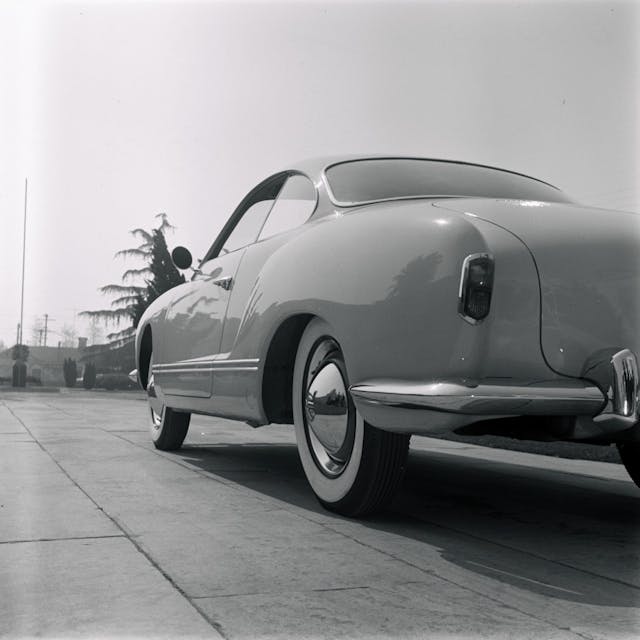
The primary aspect of any Karmann Ghia is undoubtedly its bodywork. Rust hidden beneath a gleaming exterior could lead to significant financial trouble since these vehicles required substantial effort to construct originally. Renovating them remains equally demanding, thus requiring patience during your search. Keep an eye open for collision damage, misaligned panels, and signs of decay. Corrosion within the heating ducts might go unnoticed, whereas the sill sections play a crucial role in maintaining the vehicle’s structure, particularly with convertibles. Inspect thoroughly around the interior front trunk area for indications of deterioration, along with spots under which battery acid may have eaten through the paint job. Additionally, examine common areas prone to rust such as door bases, A-pillar regions, floorboards, wheel wells, rear compartments, and window surrounds. As one professional noted wryly, "At least the roof rarely corrodes... almost never."
Even if the overall condition and build quality are solid, the state of the interior matters less since most trims can be easily obtained. However, for vehicles produced in 1960 and 1967, certain components were specific to these model years. Should you seek a car with everything meticulously original, ensure that models from those particular years come equipped with full interiors along with all their corresponding external fittings like chrome work and emblems.
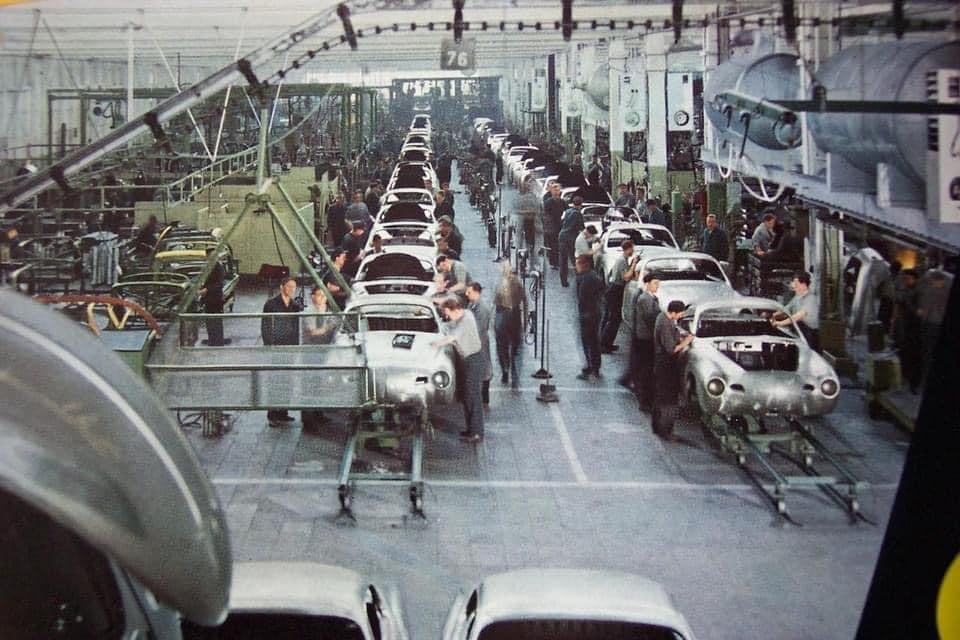
Mechanically speaking, the Karmann Ghia shares the same durability and ease of restoration and maintenance as the Beetle. A play in the lower part of the engine pulley suggests that an upcoming engine overhaul may be necessary. Additionally, watch out for more than just a slight cloud of oil smoke upon starting the vehicle when cold; this could signal worn piston rings. Changing the oil regularly every 3000 miles significantly extends the lifespan of the Volkswagen flat-four engine, with checks on valve clearance recommended at the same mileage intervals. Should you find the exhaust heat exchangers corroded and looking shabby, replacing them would prevent potentially hazardous fumes from entering the passenger compartment.
The gearboxes utilized in the Karmann Ghia models exhibit reliability and durability. If your gearbox has a gritty or resistant feel during shifting, it’s probably due to wear on the nylon block located in the selector rod, necessitating its replacement. This repair typically falls within the capabilities of many amateur mechanics at home. Additionally, calibrating the linkage might be required if the shifter tends to pop out of gear when releasing the accelerator pedal. Semi-automatic Autostick transmissions are much rarer; however, those units were robustly constructed. These systems share the same gear ratios as conventional manual gearboxes yet incorporate specific components that can be challenging to find. Unless you desire the uniqueness of this particular transmission type, opting for the regular four-speed setup could spare you from encountering numerous issues.
Early models of the Karmann Ghia require a bit more attention when it comes to maintenance because their front suspension uses kingpins that need frequent lubrication. Exercise caution with vehicles that have been modified to lower the chassis, as this is often done incorrectly. Typically, such modifications involve cutting into the suspension components and fitting new adjustable parts; therefore, request documentation from the entity responsible for carrying out these alterations to confirm they were performed properly. Adjustments to the rear suspension tend to be less complicated and can generally be restored to factory settings more easily.
Up until 1967, the Karmann Ghia was equipped with drum front brakes, which function adequately when correctly adjusted and kept up. In contrast, disc brakes demand minimal maintenance, and it’s quite straightforward to retrofit an older model with a disc brake conversion.
Which Volkswagen Karmann Ghia Suits You Best?

When it comes to choosing the right Volkswagen Karmann Ghia for your preferences, the main choice revolves around whether you want a coupe or a convertible model. Regardless of which option you pick, both clubs and spare parts suppliers offer excellent assistance. Additionally, plenty of valuable resources can be found in various publications as well as on websites such as those dedicated to VW enthusiasts. TheSamba.com.
If your preference leans towards a stylish and user-friendly vintage automobile, then the Type 14 coupe is difficult to surpass regardless of which version you choose. Enthusiasts often favor the early "low-light" variants produced until 1959. However, those who prioritize ease of daily use might prefer the later editions from 1967 onwards, equipped with front disc brakes and 12-volt electrical systems.
Convertible cars offer similar protection against the elements as any 1960s soft-top model, provided that the roof is in excellent shape. However, it strictly accommodates only two passengers, hence lacking the additional tiny rear seats typically found in most coupé variants.
When buying any classic car, individual taste along with an appropriate budget typically takes precedence. Luckily, regarding the fashionable Karmann Ghia, everyone can be a winner.
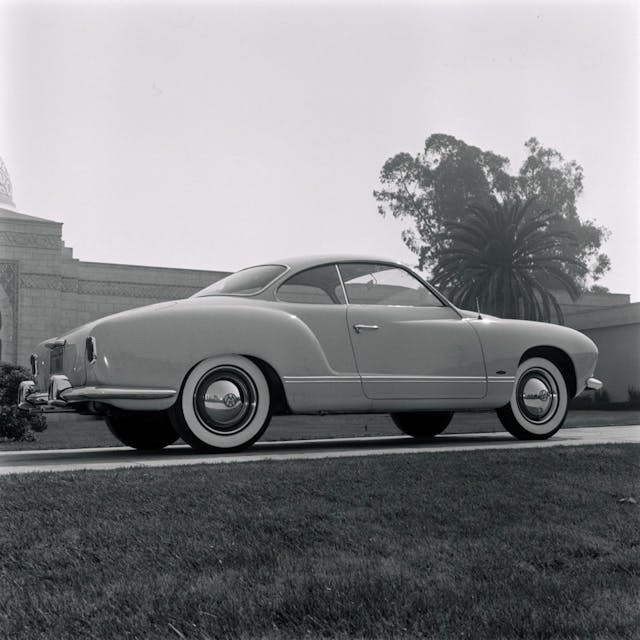
The post Your Comprehensive 1956–1974 Volkswagen Karmann Ghia Purchaser's Handbook appeared first on Hagerty Media .
Interested in buying a car? Discover your perfect match on the MSN Autos Marketplace.